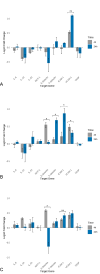Host-specific vascular endothelial cell responses to Angiostrongylus vasorum: a comparative in vitro study in red foxes (Vulpes vulpes) and domestic dogs
- PMID: 40529303
- PMCID: PMC12170705
- DOI: 10.3389/fcimb.2025.1584663
Host-specific vascular endothelial cell responses to Angiostrongylus vasorum: a comparative in vitro study in red foxes (Vulpes vulpes) and domestic dogs
Abstract
Introduction: Canine angiostrongylosis, caused by Angiostrongylus vasorum, affects dogs and red foxes, with dogs developing cardiopulmonary and coagulation disorders, while foxes remain mostly subclinical.
Methods: This study examined aortic endothelial cell responses from both species to A. vasorum adult full somatic antigen extracts, first-stage larval (L1) antigen, and adult excretory-secretory products (ESP). Differential gene expression of interleukins (IL) -6, -10, and -33, intercellular adhesion molecule 1 (ICAM-1), vascular adhesion molecule 1 (VCAM-1), endothelial selectin (E-selectin), platelet selectin (P-selectin), vascular endothelial growth factor (VEGF), and monocyte chemoattractant protein 1 (MCP-1) was assessed via reverse transcription quantitative PCR (RT qPCR) after four and 24 hours of antigen exposure.
Results: Four hours post ESP stimulation, IL-10 increased in dogs (1.8-fold) but decreased in foxes (0.4-fold). IL-33 declined in both, (0.9-fold vs. 0.7-fold, respectively). VCAM-1 was upregulated more in foxes (3.5-fold vs. 1.2 in dogs). Following adult antigen exposure, P-selectin, ICAM-1, and VCAM-1 increased in fox more than in dog cells (1.4, 1.7, and 3.1-fold vs. 0.9, 0.5, and 0.7-fold, respectively). L1 antigen downregulated IL-10 and MCP-1 in dogs (0.7 and 0.8-fold) but upregulated them in foxes (2.1 and 1.1-fold). Twenty-four hours after ESP stimulation, ICAM-1 decreased in dogs (0.8-fold) but increased in foxes (1.4-fold). VCAM-1 was downregulated in dogs (0.6-fold) but upregulated in foxes (12.9-fold). Adult antigen exposure upregulated P-selectin in both species, more in foxes (4.8-fold) than in dogs (1.9-fold). ICAM-1 was downregulated in dogs (0.8-fold) but upregulated 7.5-fold in foxes. L1 antigen stimulation caused the most substantial differences between species: IL-6 was upregulated more in dogs (4.7-fold) than foxes (1.2-fold). E-Selectin was upregulated in dogs (12.8-fold) but downregulated in foxes (0.2-fold). P-selectin increased more in dogs (10.0-fold) than in foxes (1.7-fold). ICAM-1 was downregulated in dogs (0.6-fold) but upregulated in foxes (2.6-fold), as was VCAM-1 (0.7-fold and 3.1-fold). VEGF was upregulated 9.5-fold in dogs after adult antigen exposure, and 7.6-fold after L1 antigen exposure, while it remained rather unchanged in foxes (0.9-fold and 1.0-fold, respectively).
Discussion: These findings corroborate that foxes have developed mechanisms for a regulated immune response following A. vasorum exposure, while dogs exhibit a higher pro-inflammatory reaction, contributing to severe clinical outcomes. Host-parasite co-evolution may explain differences in the pathogenesis and clinical presentation of canid angiostrongylosis.
Keywords: canid angiostrongylosis; comparative immunobiology; endothelial activation; host-parasite interaction; host-specific response; pathogenesis; vascular endothelium.
Copyright © 2025 Eisenhut, Wittwer, Schnyder and Oehm.
Conflict of interest statement
The authors declare that the research was conducted in the absence of any commercial or financial relationships that could be construed as a potential conflict of interest.
Figures




Similar articles
-
Host-specific serological response to Angiostrongylus vasorum infection in red foxes (Vulpes vulpes): implications for parasite epidemiology.Parasitology. 2017 Aug;144(9):1144-1153. doi: 10.1017/S0031182017000427. Epub 2017 May 8. Parasitology. 2017. PMID: 28478766
-
Cardio-pulmonary nematodes of the red fox (Vulpes vulpes) of Sardinia, Italy.Parasitol Res. 2023 Jul;122(7):1685-1688. doi: 10.1007/s00436-023-07882-8. Epub 2023 May 22. Parasitol Res. 2023. PMID: 37212835 Free PMC article.
-
Angiostrongylus vasorum in Romania: an extensive survey in red foxes, Vulpes vulpes.Parasit Vectors. 2017 Jul 12;10(1):330. doi: 10.1186/s13071-017-2270-x. Parasit Vectors. 2017. PMID: 28701176 Free PMC article.
-
A systematic review and meta-analysis of circulating adhesion molecules in rheumatoid arthritis.Inflamm Res. 2024 Mar;73(3):305-327. doi: 10.1007/s00011-023-01837-6. Epub 2024 Jan 19. Inflamm Res. 2024. PMID: 38240792 Free PMC article.
-
Angiostrongylus vasorum in the eye: new case reports and a review of the literature.Parasit Vectors. 2016 Mar 21;9:161. doi: 10.1186/s13071-016-1440-6. Parasit Vectors. 2016. PMID: 27000634 Free PMC article. Review.
References
Publication types
MeSH terms
Substances
LinkOut - more resources
Full Text Sources
Research Materials
Miscellaneous

